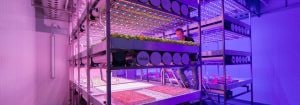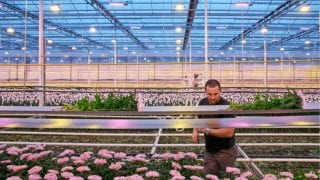Be the first! Get the latest news and updates - Subscribe to our newsletter!
Follow us on a new journey combining floriculture and vertical farming
In the last 10 years, many companies have sprung up to grow herbs and greens in climate-controlled vertical farm or city farm facilities which are daylight-free. As a plant specialist for floriculture I’ve watched these developments with great interest. But I have wondered if a vertical farm can also benefit cultivation of young plants from floriculture crops. Time to roll up on sleeves and try it myself.
Cultivating floriculture crops without daylight
Growing plants under daylight is the standard practice in conventional greenhouses. But as the popularity of vertical farms has increased, we as plant specialists have been asking ourselves if it is possible to grow floriculture crops without the influence of daylight. Why would growers want to do this? In a greenhouse, the sun affects both the amount of light that the plant receives as well as the temperature and humidity of the growing environment. A controlled environment removes the influence of daylight on the plant’s growth. This would allow growers to strictly control the growing climate to best meet the needs of each plant throughout the day.
Cultivating in a controlled environment also allows growers to optimize other factors, like plant quality and growth speed, and reduce water usage. Since fewer diseases and bacteria come into the controlled environment, vertical farming can also help stop the use of insecticides and fungicides.

Set-up of floriculture trial
These benefits prompted us to conduct a floriculture trial in our climate-controlled test facility at BrightBox in Venlo. Most of the requests we receive are from growers of young plants, so we ran a trial on the propagation phase of flowers. We chose a wide range of annual and perennial plants, including Begonias, Petunias, Calibrachoas, Dianthus, Gerberas, Celosias, Alternatheras and Impatiens.
For this trial, we translated the cultivation conditions of a greenhouse to a climate-controlled environment and added the experience of our colleague City Farm plant specialists. Light levels were chosen based on the reference greenhouse environment with daylight, as well as scientific literature and the experience of growers. The light spectra used in the test were aligned with a number of growers to meet their quality standards for the different varieties of flowers. Growth speed is one requirement from growers, but good plant quality is the first priority. In this case, a plant is considered good if it has a compact shape, enough leaves and branches and a good root system. In addition, a good plant should be able to quickly establish roots and bloom as it moves to its next growth phases.
By drawing upon our experiences and the scientific literature we were able to extract enough insights to develop light recipes that would produce these plant characteristics. For example, many plants react to a higher amount of blue light by becoming more compact. The length of the internodes becomes shorter. Some plants benefit from far red light by germinating faster and developing stronger roots, while other react by bolting and drooping.
Results from floriculture trial
Our results showed that as expected, each variety of flower reacts differently to a light recipe. The climate settings are also important in this respect. Higher temperatures resulted in faster, but less compact and less robust growth. The results confirmed that growing floriculture young plants in a daylight-free environment is possible and all about finding the right balance between climate factors and lighting. In fact the choice of light intensity and light spectrum plays an even greater role in a vertical farm than in a greenhouse.
This is just a first screening, but the trial gave us clear insight into the possibilities of cultivating diverse varieties of young annuals and perennials in a daylight-free environment. As with all trials, there were also plants that did not fare well as a result of a certain light recipe. But we learned from these results as well. The majority of the light recipes tested produced good results in terms of compact, robust plants with a good root system. There is plenty of room for optimization, depending on the most desirable characteristic for a specific variety. We also saw that it is definitely possible to cultivate good quality plants for several crops under one light recipe.

Flowers can flourish in a city farm
What does this mean for floriculture growers? We are convinced that for every single type of crop you want to grow, we can develop the right growth recipe for a city farm. This is just the beginning of the journey. However, we already see plenty of reasons for the floriculture sector to look beyond the greenhouse to discover the possibilities that a daylight-free growing environment can offer to improve their crops.

Leontiene van Genuchten is a plant specialist for floriculture at Signify (formerly known as Philips lighting). She is a practical researcher in heart and soul with an eye towards meeting the needs of growers. Since she began working at Signify in 2015, Leontiene has been collaborating with researchers and growers to develop and improve Philips LED lighting technologies that are in floriculture.
Related articles
Contact us
Contact certified partners
Philips products are sold through a global network of certified partners. Find partners in your region for more information about Philips LED grow lights.
Contact Philips
What are the best LED grow lights for your situation? We are here to help. Please use our form to submit your request.
Subscribe to newsletter
Keep up to date about Philips LED lighting in horticulture by subscribing to our newsletter.
Join our team
Interested in discovering your recipe for growth and joining our team? Take a look at our career page for more information.
Interested?
Learn more about LED lighting in horticulture by reading our latest articles and case studies.


